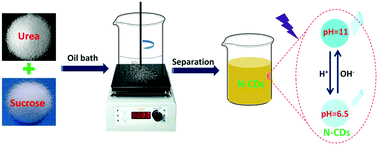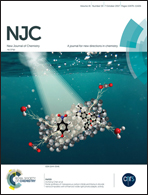N-Doped carbon dots: green and efficient synthesis on a large-scale and their application in fluorescent pH sensing†
Abstract
A green and efficient anhydrous strategy was developed for one-step synthesis of nitrogen-doped carbon dots (N-CDs) using sucrose and urea as carbon and nitrogen source, respectively. The reaction was carried out at ambient pressure by directly adding the mixture of sucrose and urea powder into heated edible oil. N-CDs could be generated in several minutes and were obtained by facile separation of the edible oil, which could be reused. This is therefore a green method and suitable for the synthesis of N-CDs on a large-scale. The as synthesized N-CDs possessed higher photostability, excellent optical properties and ultra-low cytotoxicity. Noticeably, the N-CDs exhibited a distinct pH-sensitive feature, and their fluorescent intensity increased linearly in the pH range from 6.75 to 11.0. Therefore, the as synthesized N-CDs can be used to construct pH fluorescent sensor, and the successful pH monitoring of environmental water samples demonstrates their applicability in complex matrixes. Our work would open up a new avenue for the green and convenient synthesis of high-performance heteroatom-doped materials on a large-scale.



 Please wait while we load your content...
Please wait while we load your content...